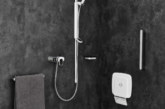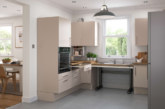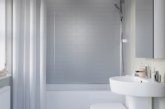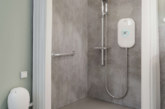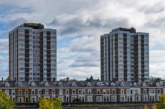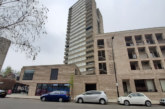Good lighting in any bathroom is essential for the avoidance of accidents, however in an accessible bathroom, the need for safety increases dramatically. Stuart Reynolds from AKW shows how social landlords and facilities managers can ensure that their accessible bathrooms are well lit, to minimise falls and other accidents.
The importance of good lighting cannot be underestimated; being able to see a space clearly benefits movement, balance, gait and stability and ultimately improves a person’s overall safety.
Kate Sheehan, Occupational Therapist underlines the importance of lighting: “Tasks carried out in a bathroom often require close working e.g. shaving and make up application, or intimate personal hygiene e.g. wiping after going to the toilet or washing between the toes. All of these actions require the occupational therapist to maximise the client’s ability to perform the task and lighting is a critical part of the assessment and specification.”
A mix of task and ambient lighting
Good bathroom lighting needs to deliver adequate light levels for the user to perform a variety of tasks around the space, including showering, shaving and other personal care activities. For those with low vision or mobility issues, the avoidance of shadows, dark areas and glare is key to safe movement around the space.
Key factors include:
- Ambient lighting with LEDs — LED lights are highly energy-efficient and provide shadow free illumination, ideal for those with visual impairment issues or those with dementia. To maintain ambient light levels in the bathroom, LED ceiling lights should be spaced to maximise coverage and minimise shadowing
- Narrow beam LED downlights — To highlight tasks such as shaving, washing etc. narrow beams of light are needed on specific spaces, such as the shower area or sink. Most LED downlights on the market have a beam angle of 60˚, however for those with low vision or mobility issues, a specialist task light with a 30˚ beam angle is required.
- Easy to use light switch or pull cord — either a rocker switch or easy to hold pull cord is advised for use in accessible bathrooms. For those with visual impairment issues, a cord in a high-contrast colour is ideal.
- Mirror lighting — lights over mirrors, or embedded within the frame as a decorative feature are aesthetically appealing and also ideal for those looking for task-specific lighting for shaving or make-up application.

What lights to put where?
For a standard sized UK bathroom (sized approximately 8ft by 6ft or 2,438 by 1,829mm), it is recommended that two ambient LED ceiling lights are used, as well as task lights — distributed in the following way (with the user no closer than 300mm to any given task light):
- Toilet — 1 task light
- Hand basin — 1 task or mirror light
- Shower — 3 task lights (for a space of 1,500 by 1,500mm)
- And/or Bath — 3 task lights
AKW helps with tailored Task Focused Lighting Kit for accessible bathrooms
To help social landlords and facilities managers, AKW has created a bathroom lighting pack. It contains everything needed to light a standard UK bathroom and the products conform to all relevant industry standards for a bathroom installation:
- 5 x narrow beam (30˚) ceiling LED task lights: three for the bath/shower zone and two for the toilet and sink areas.
- 2 x long lasting, bright (1,764lm) LED ceiling lights for the ambient lighting of the space.
- 1 x blue pull-cord switch.
Good bathroom lighting can mean the world to those struggling with mobility, dementia or visual impairment issues. With a little time and investment, good bathroom lighting has the potential to promote independence as well as to help reduce accidents.
The seven characteristics of good lighting
According to the Thomas Pocklington Trust, a charity dedicated to delivering positive change to those with sight loss, significant lighting improvements can be achieved by:
- Tailoring the lighting to specific needs — creating a visual environment that supports a person’s chosen ambience and activities
- Ensuring the lighting is for specific tasks, orientation and movement — create a safe minimum level of ambient light and task focused lighting to illuminate specific areas of importance.
- Maintaining even light levels, with minimum glare-deep shadows or sharp changes in light levels should be avoided. To minimise glare, the bright areas of light sources should not be directly visible from normal directions of view.
- Incorporating adjustment for flexibility — incorporating switching, dimming or different lighting elements for specific needs.
- Making sure the lighting is energy efficient — appropriate lighting should be selected to meet user needs without wasting energy. This can be achieved using LED lighting.
- Prioritising ease of installation where possible to minimise disruption — use existing wiring and fittings, or alter switches to more user-friendly versions before implementing any major changes.
- Planning the adaptation to suit the future — choose adaptations that respond to changing needs, new occupants and lighting innovations.
Stuart Reynolds is Head of Product and Marketing at AKW


